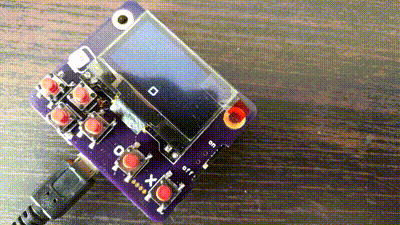I'm still waiting for the attiny chips for the button handling, but I realized that my display driver is not really suitable for making games. Sure, it has that cool dirty pages stuff that makes it fast, but it only can draw a pixel at a time. That's not how you are going to get nice smooth animations. We need a blit operation — something that will let me draw a whole sprite in one operation.
The way blit works, it takes whole bytes, shifts them as required, and combines with the current frame buffer using one of the logic operators. For a start I have chosen xor. Why? Because that's the easiest way to have sprites that don't delete the background as they move around — you blit them once to show them, and you blit them a second time to make them disappear. Sure, they don't look pretty when they collide with something, but it's a start. Later I can do similar operations with or and and, so that I can have pretty sprites with a mask. For now I have a bouncing box:

This is done with this code:
import microbit
class SH1106:
_command = bytearray(b'\x00\xb0\x02\x10')
def __init__(self):
self.buffer = bytearray(1024)
self.dirty_min = bytearray([0] * 8)
self.dirty_max = bytearray([128] * 8)
microbit.i2c.init(freq=400000, scl=microbit.pin2, sda=microbit.pin1)
for i in range(2):
# First two transaction after init always fail.
try:
microbit.i2c.write(0x3c, b'')
except OSError:
pass
_init = (b'\x00\xae\xd5\x80\xa8\x3f\xd3\x00\x40\x80\x14'
b'\x20\x00\xa1\xc8\xa1\xda\x12\x81\xcf\xd9\xf1'
b'\xdb\x40\xa4\xa6\xaf')
microbit.i2c.write(0x3c, _init)
microbit.i2c.write(0x3c, _init)
def show(self):
index = 0
buf = self.buffer
for page in range(8):
dmin = self.dirty_min[page]
dmax = self.dirty_max[page]
if dmax:
self._command[1] = 0xb0 | page
self._command[2] = 0x00 | ((2 + dmin) & 0x0f)
self._command[3] = 0x10 | ((2 + dmin) >> 4) & 0x0f
microbit.i2c.write(0x3c, self._command)
microbit.i2c.write(0x3c,
b'\x40' + buf[index + dmin:index + dmax])
index += 128
self.dirty_max[page] = 0
self.dirty_min[page] = 127
def pixel(self, x, y, color=None):
if not 0 <= x < 128 or not 0 <= y < 64:
return
page = y // 8
index = x + page * 128
mask = 1 << (y % 8)
if color is None:
return bool(self.buffer[index] & mask)
elif color:
self.buffer[index] |= mask
else:
self.buffer[index] &= ~mask
self.dirty_max[page] = max(self.dirty_max[page], x + 1)
self.dirty_min[page] = min(self.dirty_min[page], x)
def xor(self, x, y, data):
if not -8 < x < 128:
return
if x < 0:
data = data[-x:]
x = 0
elif x > 120:
data = data[:120 - x]
page = y // 8
shift = y % 8
if 0 <= page <= 7:
index = x + page * 128
for byte in data:
self.buffer[index] ^= byte << shift
index += 1
self.dirty_min[page] = min(self.dirty_min[page], x)
self.dirty_max[page] = max(self.dirty_max[page], x + 8)
page += 1
if 0 <= page <= 7 and shift:
index = x + page * 128
shift = 8 - shift
for byte in data:
self.buffer[index] ^= byte >> shift
index += 1
self.dirty_min[page] = min(self.dirty_min[page], x)
self.dirty_max[page] = max(self.dirty_max[page], x + 8)
display = SH1106()
box = b'\xff\x81\x81\x81\x81\x81\x81\xff'
x = 0
y = 0
dx = 1
dy = 1
while True:
display.xor(x, y, box)
display.show()
display.xor(x, y, box)
x += dx
y += dy
if not 0 <= x < 120:
dx = -dx
if not 0 <= y <= 56:
dy = - dy
microbit.sleep(10)So I can easily blit 8x8 sprites (and tiles). If I want bigger ones, I can just compose them out of those 8x8 blocks — it's not going to be considerably slower.
 deʃhipu
deʃhipu
Discussions
Become a Hackaday.io Member
Create an account to leave a comment. Already have an account? Log In.